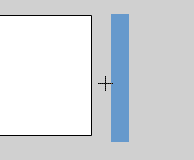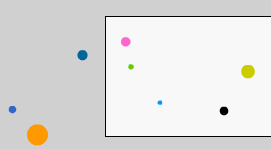 Creating
Continuous
Movement
Creating
Continuous
Movement
by
kirupa chinnathambi
A popular feature of my site (kirupa.com) has
been the scrolling circles, emoticons, squares, etc. that
can be found on my homepage and in my forum footer. People
often ask me how I created that animation, and, needless to
say, they walked away after I gave a long, winding
explanation. Therefore, I decided I will create a tutorial
that walks the user through the steps easily instead of
confusing them through "flashnetized" babble.
The following animation is what I am
referring to, and, yes, you will create
something similar by the time you reach the end of this
tutorial:
[ movement by programming at only 856
bytes! ]
The above animation is what you will learn
how to create. I will guide you through creating the movie,
customizing the movie, and hopefully helping you understand
the code and why it works the way it does. While this
tutorial is geared for Flash MX, you should be able to make
this effect work in Flash 5.
Creating Continuous Movement:
-
Create a new movie in Flash
MX. Set the width and height of your movie to 300 by 120
respectively. Lastly, make sure to set the frame-rate to
at least 25 fps.
-
We need to create a buffer
zone
for all the circles to stop at. Beyond the right edge of your
stage, draw a rectangle. Make sure the rectangle is about
the height of your movie and is a good 20-30 pixels away
from the movie stage:

[ the
rectangle has been drawn beyond the right edge of the stage
]
-
After the rectangle has been drawn, select it and press
F8. The Convert to Symbol dialog box will appear. Select
Movie Clip and press OK. Select the rectangle (now a movie
clip) and give it the instance name "block":

[ give the
rectangle the instance name 'block' ]
-
It is time to draw the circles! Inside of your stage, draw
a circle. Once you have drawn the circle, press F8. The
Convert to Symbol dialog box will appear. Select Movie
Clip and press OK.

[ the
convert to symbol dialog box ]
-
After you made the circle a movie clip, right click on the
circle and select Actions:
Copy and paste the following code into your Actions dialog
box:
[ copy and paste the above
code into your movie clip's actions dialog box ]
-
After the rigorous process of Copying and Pasting you
undertook in Step 3, select your movie clip with your mouse
pointer. Press F8 again and select Movie Clip (again) from
the Convert to Symbol dialog box that appears.
[ NOTE ]
Make sure
you do not forget the select the movie clip, press F8, and
select the Movie Clip option from the Symbol Dialog box as
mentioned in Step 4.
-
Right click on the circle and select Copy. Paste your circle
in random locations throughout the movie.
-
Keep repeating the copy/paste routine until you get enough
circles dotting your movie clip. Because this is a movie
clip, you can adjust the scale and tint/alpha settings to
make your circles look "cool". Therefore, adjust
the tine/alpha/scale/etc. of your circles to make them
colorful and bright:

[ randomly
arrange your circles in different colors/locations ]
-
Ensure that a few circles are outside the boundaries of the
stage on the left side. See the image above; notice the
three circles in the gray area outside the stage. This is
done to ensure a seamless transition without any pauses or
gaps in the animation while the circles are being
"respawned" on the left.
-
Save the animation and go to File | Publish Preview | HTML.
You will see the circles you created move to the left and
re-appear on the right.
Customizing the Animation
Unless you plan on having your animation
be 300 pixels by 120 pixels (width x height) always,
you may need to know how to modify some data to
custom-tailor the effect for your own animation.
Find the line of code that you pasted that
contains the number -1000. That number represents the
number of pixels back the circles will "respawn" after
hitting their right buffer (the rectangle). If your
animation is wider than 300 pixels, make sure you increase
the number -1000 to something greater (less actually) such
as -1200.
Increasing that number ensures that you will not have
circles that sporadically spawn in the middle of the
animation instead of beyond the left edge. There is no
factor that you can multiply the width of your movie by to
get the magical number. The location of the re-spawn depends
on how you scaled the movie; if you scaled down, the chances
of your movie clip spawning in the middle of your animation
are greater. Flash takes into account the scaling of your
movie clip and adjusts the movie clip's movement
accordingly. This is kind of confusing, so experiment with
the value! Only by trial and error will you find out what
you intend to do.
You are officially done with this
tutorial. While I cannot force you to read beyond this, you
will gain some valuable ActionScript knowledge so you can
tweak the code to your own liking.
You can download the FLA I used in writing
this tutorial so you can compare my animation with that of
yours:
ActionScript Explanation
You pasted a big chunk of ActionScript
into a movie clip a few instructions ago. If you are like
me, you probably did not pay much attention to what the code
contained. You are probably, also, confused at the
explanations in the customization section I wrote. That is why I have provided in the next few
sections a detailed walkthrough of why/how the code works
the way it works.
Click the
Next Page link to learn the
nitty-gritty secrets of why the animation behaves the way it
does.
|